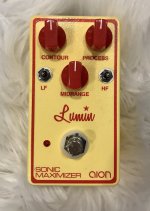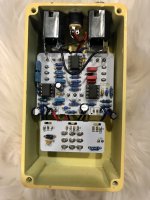You are using an out of date browser. It may not display this or other websites correctly.
You should upgrade or use an alternative browser.
You should upgrade or use an alternative browser.
Aion Lumin (BBE Sonic Stomp)
- Thread starter joelorigo
- Start date
joelorigo
Well-known member
Thank youNice looking pedal
Like the labelling and colours just looks excellent
Chuck D. Bones
Circuit Wizard
Looks great!
Kevin at Aion makes nice boards but he could add a few more ground pads. I've had to do what you did and daisy-chain the grounds. On the topic of grounding, you might want to remove some paint around the jacks, switches & pots on the inside to ensure good grounding.
Kevin at Aion makes nice boards but he could add a few more ground pads. I've had to do what you did and daisy-chain the grounds. On the topic of grounding, you might want to remove some paint around the jacks, switches & pots on the inside to ensure good grounding.
joelorigo
Well-known member
Thanks! i did, for the first time, take a file to the holes for the jacks on this pedal and another one I just finished. I posted a question about grounding issues with painted enclosures last week in the ‘general questions’ area. The response was to make sure the jacks touch the aluminum. I should to the any switches and pots too?Looks great!
Kevin at Aion makes nice boards but he could add a few more ground pads. I've had to do what you did and daisy-chain the grounds. On the topic of grounding, you might want to remove some paint around the jacks, switches & pots on the inside to ensure good grounding.
joelorigo
Well-known member
Also, what happens when there is a short because of paint preventing contact? Is there no signal? Extra noise?Looks great!
Kevin at Aion makes nice boards but he could add a few more ground pads. I've had to do what you did and daisy-chain the grounds. On the topic of grounding, you might want to remove some paint around the jacks, switches & pots on the inside to ensure good grounding.
Chuck D. Bones
Circuit Wizard
Thanks! i did, for the first time, take a file to the holes for the jacks on this pedal and another one I just finished. I posted a question about grounding issues with painted enclosures last week in the ‘general questions’ area. The response was to make sure the jacks touch the aluminum. I should to the any switches and pots too?
It doesn't hurt and it can help. Any stray metal that isn't grounded can act like an antenna and pickup noise or unwanted signal.
Chuck D. Bones
Circuit Wizard
Also, what happens when there is a short because of paint preventing contact? Is there no signal? Extra noise?
The enclosure needs to grounded to the circuit for it to be an effective shield against hum & noise. Most jacks are metal and connected to circuit ground. They provide an easy means to ground the enclosure.
joelorigo
Well-known member
Cool. I will make it a habit to file the paint out of all the holes from now on.It doesn't hurt and it can help. Any stray metal that isn't grounded can act like an antenna and pickup noise or unwanted signal.
Chuck D. Bones
Circuit Wizard
Just to be clear, you want to scrape the paint off of the inside surface next to the holes.
joelorigo
Well-known member
Oh, not the inside of the holes? Or both?Just to be clear, you want to scrape the paint off of the inside surface next to the holes.
Chuck D. Bones
Circuit Wizard
The holes only need to be big enough for the pot, switch, etc. to fit. There is no guarantee that the pot will contact the edges of the hole. Filing the inside surface is mandatory in my book. Filing the inside of the holes is optional. I use a wire wheel on a drill press to make quick work of it. Rough sandpaper will also work, but takes longer. Tayda lays the paint on pretty thick, which is a good thing for the outside, not so good on the inside.
joelorigo
Well-known member
Got it!The holes only need to be big enough for the pot, switch, etc. to fit. There is no guarantee that the pot will contact the edges of the hole. Filing the inside surface is mandatory in my book. Filing the inside of the holes is optional. I use a wire wheel on a drill press to make quick work of it. Rough sandpaper will also work, but takes longer. Tayda lays the paint on pretty thick, which is a good thing for the outside, not so good on the inside.
Chuck D. Bones
Circuit Wizard
Maybe a piece of masking tape to cover the holes on the inside of the enclosure when painting? Then one wouldn't have to sand the paint off.
True, but the enclosures we have the most trouble with are the powder-coated ones we buy from Tayda. I don't need masking tape on the ones I paint myself because I only spray the outside. What little bit gets inside isn't enough to interfere with grounding.
joelorigo
Well-known member
Ah, maybe that's why I haven't had a problem yet.True, but the enclosures we have the most trouble with are the powder-coated ones we buy from Tayda. I don't need masking tape on the ones I paint myself because I only spray the outside. What little bit gets inside isn't enough to interfere with grounding.
We generally use metal enclosures because if the enclosure is metal and is grounded it acts as a Faraday cage; ie it shields the circuit within from external radio waves and electromagnetic interference by sending that noise to ground rather than letting it be amplified by your circuit. The Faraday cage is named after Michael Faraday, early electronics pioneer after whom the unit for capacitance is also named: the Farad.
I only mention this because it is one of the few electronics things I actually know. That and don't fly metal kites in thunder storms.
I only mention this because it is one of the few electronics things I actually know. That and don't fly metal kites in thunder storms.
Similar threads
- Replies
- 3
- Views
- 311



